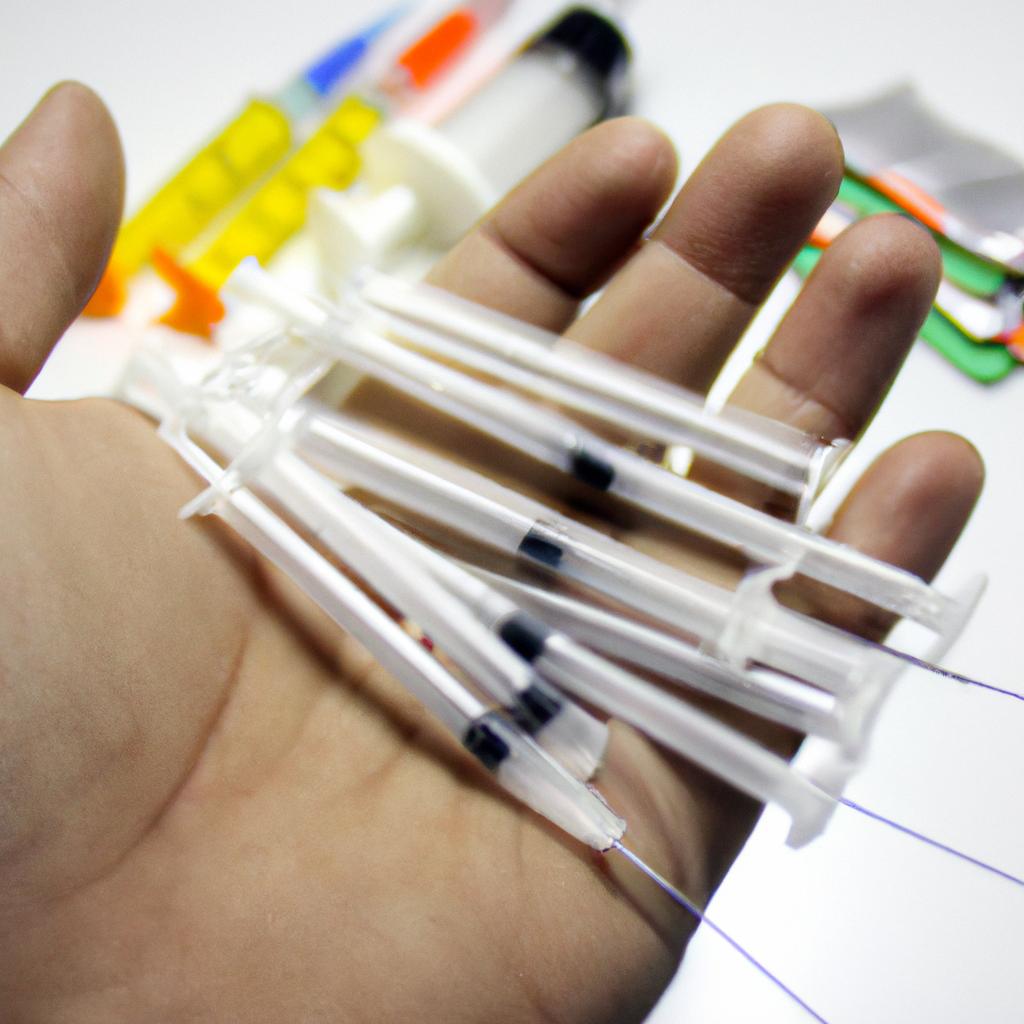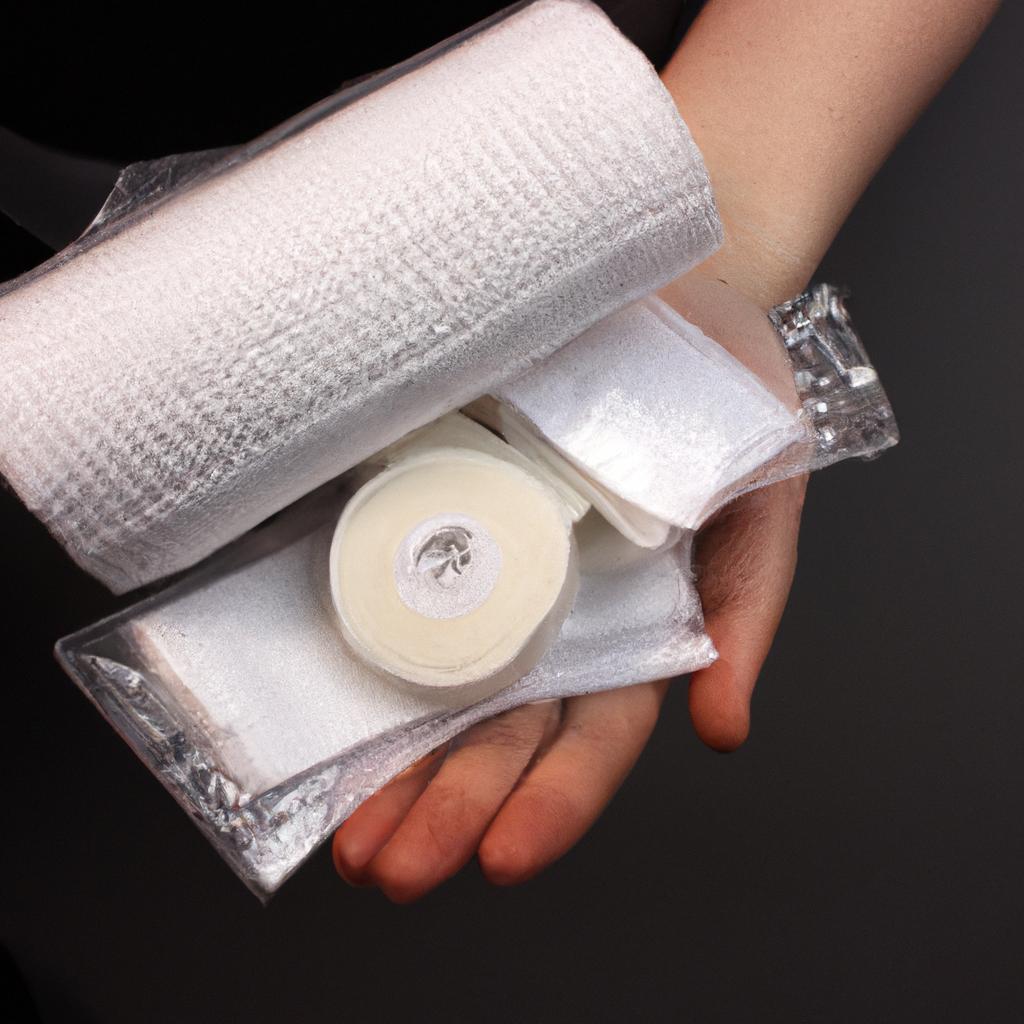The use of disposable masks has become increasingly prevalent in recent times, particularly due to the ongoing COVID-19 pandemic. These masks serve as a vital protective measure against airborne pathogens and are widely used across various settings such as healthcare facilities, workplaces, and public spaces. This article aims to provide an essential guide on mask disposables, offering insights into their types, functionalities, and best practices for usage.
Consider a hypothetical scenario where Sarah works in a bustling office environment amid the pandemic. As she navigates through her daily routine, interacting with colleagues and clientele, she relies on a disposable mask to safeguard herself and those around her from potential virus transmission. In this context, understanding the different aspects of mask disposables becomes crucial – from choosing the right type of mask to ensuring proper usage and disposal methods. By delving into these intricacies, individuals like Sarah can make informed decisions regarding their choice and utilization of disposable masks effectively.
Within this guide, we will explore the various types of disposable masks available in the market and delve into their respective features and benefits. Additionally, we will discuss key considerations when selecting a suitable mask based on factors such as filtration efficiency, comfort level, and intended use case scenarios. Furthermore, this article will highlight important guidelines for proper donning and doffing of disposable masks, emphasizing the importance of a secure fit and minimizing the risk of contamination during mask handling.
Proper disposal methods are also crucial to prevent potential environmental hazards. We will provide detailed instructions on how to safely remove and dispose of used masks, considering factors such as material composition, local regulations, and global sustainability efforts. By following these guidelines, individuals can contribute to the responsible management of mask waste and reduce their ecological footprint.
Lastly, we will address common misconceptions and myths surrounding disposable masks, clarifying their effectiveness in preventing viral transmission and debunking any false claims or misinformation. It is essential for individuals like Sarah to have accurate information about mask disposables to make informed decisions regarding their health and safety.
Overall, this comprehensive guide aims to equip individuals with the knowledge necessary for utilizing disposable masks effectively. By understanding the different types available, adhering to best practices for usage and disposal, and staying informed about their functionality and limitations, individuals can confidently navigate through daily activities while prioritizing their well-being and that of others around them.
Why Use Mask Disposables?
Introduction
Imagine you are a healthcare worker in a bustling hospital, attending to patients with various respiratory illnesses. One of your primary concerns is protecting yourself and others from infectious pathogens. In such situations, the use of mask disposables becomes essential. This section explores why mask disposables are crucial and highlights their advantages over other alternatives.
The Advantages of Mask Disposables
Firstly, mask disposables offer superior protection against airborne particles compared to reusable masks. Unlike reusable masks that may accumulate contaminants over time and require regular cleaning, disposable masks provide a fresh barrier every time they are used. This ensures maximum filtration efficiency, reducing the risk of inhaling harmful pollutants or viruses.
Secondly, the convenience factor cannot be ignored when considering mask disposables. Imagine being in a high-risk environment where constant masking is required for extended periods. Reusable masks would need frequent washing or replacement throughout the day, leading to disruption and potential contamination during handling. On the contrary, disposable masks can simply be discarded after each use without any hassle or additional steps involved.
Furthermore, mask disposables have proven effectiveness in preventing the spread of diseases within communities. Their widespread adoption during outbreaks has been instrumental in curbing transmission rates by minimizing contact between individuals through contaminated surfaces on reusable masks.
To further emphasize the importance of using mask disposables, let’s consider some key points:
- Improved Hygiene: Disposable masks eliminate cross-contamination risks associated with reusing infected or soiled fabric.
- Ease of Use: With no cleaning requirements or complex maintenance procedures, disposable masks are ready-to-use at all times.
- Affordability: While initial costs may vary depending on brand and quality, long-term expenses associated with laundering or replacing reusable masks surpass those related to disposable ones.
- Consistent Quality: Each new disposable mask guarantees consistent filtration performance unlike reusable options that deteriorate over time.
| Advantage | Description |
|---|---|
| Improved Hygiene | Disposable masks eliminate cross-contamination risks associated with reusing infected or soiled fabric. |
| Ease of Use | With no cleaning requirements or complex maintenance procedures, disposable masks are ready-to-use at all times. |
| Affordability | While initial costs may vary depending on brand and quality, long-term expenses associated with laundering or replacing reusable masks surpass those related to disposable ones. |
| Consistent Quality | Each new disposable mask guarantees consistent filtration performance unlike reusable options that deteriorate over time. |
Conclusion
In summary, the use of mask disposables provides several advantages in terms of enhanced protection, convenience, and public health benefits. Their ability to offer superior filtration efficiency, coupled with their ease of use and affordability, makes them an indispensable tool for individuals working in high-risk environments or during disease outbreaks.
Transitioning into the subsequent section about “Different Types of Mask Disposables,” it is important to explore how various types of these disposables cater to specific needs and scenarios without compromising safety measures.
Different Types of Mask Disposables
Section H2: The Benefits of Mask Disposables
Consider the case study of Jack, a healthcare worker who consistently wore reusable cloth masks during his shifts at a busy hospital. Despite diligent washing and sanitizing, he found himself frequently falling ill with respiratory infections. Frustrated by this recurring issue, Jack decided to switch to mask disposables, eager to explore their potential benefits. This section will delve into the advantages offered by mask disposables and shed light on why they are becoming increasingly popular.
Firstly, mask disposables provide superior protection against airborne particles compared to reusable cloth masks. They are specifically designed with multiple layers of filtration materials that effectively block out microscopic particles such as bacteria and viruses. The tight fit of disposable masks also ensures minimal leakage around the edges, reducing the risk of inhaling potentially harmful pathogens.
Secondly, mask disposables offer convenience and ease of use. Unlike reusable masks that require regular cleaning and maintenance, disposable masks can simply be discarded after each use. This eliminates the need for laundering or disinfecting, saving time and effort for individuals in various settings such as hospitals, workplaces, or public spaces.
Furthermore, using mask disposables promotes better hygiene practices. Reusable cloth masks may accumulate dirt and moisture throughout the day, creating an environment conducive for bacterial growth. On the other hand, disposable masks minimize contact with contaminants as they are used only once before being disposed of safely. This reduces the chances of cross-contamination between wearers and helps maintain cleaner environments.
To emphasize these key points further:
- Disposable masks offer superior protection against airborne particles.
- They provide convenience through easy disposal after each use.
- Using them promotes better hygiene practices.
- Their design ensures minimal leakage around the edges for increased safety.
| Benefit | Description |
|---|---|
| Superior Protection | Multiple layers of filtration materials effectively block out microscopic particles like bacteria and viruses. |
| Convenience and Ease of Use | Disposable masks can be discarded after each use, eliminating the need for cleaning or maintenance. |
| Promotion of Better Hygiene | Reduced contact with contaminants helps minimize cross-contamination between wearers and maintains cleaner environments. |
With their superior protection, convenience, and hygiene benefits, mask disposables are proving to be an advantageous choice in various settings.
Now that we have established the benefits of mask disposables, let’s delve into choosing the most suitable option for your individual circumstances – selecting a mask disposable that meets your unique needs is crucial in ensuring optimal safety and comfort.
Choosing the Right Mask Disposables
In the previous section, we explored the various types of mask disposables available in the market. Now, let us delve deeper into understanding these different options and how they cater to diverse needs.
Consider a scenario where you find yourself working in a highly polluted environment. The air quality index is alarmingly high, posing serious health risks. In such a situation, wearing a basic surgical mask might not provide sufficient protection against harmful particles suspended in the air. This highlights the importance of selecting the right type of disposable mask that suits your specific requirements.
To help you make an informed decision, here are some key factors to consider when choosing mask disposables:
- Filtration Efficiency: Look for masks with higher filtration efficiency ratings, such as N95 or KN95 masks which filter out at least 95% of airborne particles.
- Comfort and Fit: Opt for masks with adjustable nose clips and ear loops for a secure fit. It should cover both your mouth and nose snugly without causing discomfort.
- Breathability: Masks with good breathability allow for easier airflow while still providing adequate protection.
- Durability: Consider the durability of the mask material to ensure it lasts throughout its intended usage period.
Now, let’s take a closer look at how different types of mask disposables compare in terms of their features:
| Type | Filtration Efficiency | Comfort & Fit | Breathability |
|---|---|---|---|
| Surgical Masks | Moderate | Varies | Good |
| N95 Respirators | High | Excellent | Slightly Restricted |
| Cloth Masks | Varies | Depends | Depends |
Please note that this table serves as a general guide and individual product specifications may vary. Make sure to read product labels or consult healthcare professionals for accurate information before making your purchase.
Understanding the differences between mask disposables is crucial in choosing the most suitable option for your specific needs.
Equipped with knowledge about different types of mask disposables and how they cater to diverse needs, let us now delve into the vital aspect of properly using and disposing these masks.
Proper Usage and Disposal of Mask Disposables
Having explored the various factors to consider when choosing mask disposables, it is crucial to understand their proper usage and disposal. By following these guidelines, you can ensure maximum effectiveness while also minimizing environmental impact.
Paragraph 1:
To illustrate the importance of proper usage and disposal, let’s consider a hypothetical scenario. Imagine an individual who wears a disposable mask throughout the day without changing it or disposing of it properly. As time passes, moisture from breathing accumulates within the mask, creating an ideal breeding ground for bacteria and other microorganisms. Not only does this compromise the efficacy of the mask in filtering out particles, but it also poses potential health risks to the wearer themselves. This example highlights why understanding how to use and dispose of mask disposables correctly is paramount.
- Proper Fit: Ensure that your mask fits snugly over your nose and mouth, with no gaps on the sides.
- Avoid Touching: Refrain from touching your face or adjusting the mask unnecessarily while wearing it.
- Limited Wear Time: Replace your disposable mask after using it continuously for four hours or if it becomes visibly soiled or damaged.
- Appropriate Disposal: Dispose of used masks in designated waste bins or follow local regulations regarding proper disposal methods.
Paragraph 2:
In addition to adhering to proper usage practices, understanding how to dispose of mask disposables responsibly is essential for reducing negative environmental impacts. Here is a table outlining different types of masks commonly used during the COVID-19 pandemic along with their respective decomposition times:
| Type | Decomposition Time (in years) |
|---|---|
| Surgical Masks | 450 |
| N95 Respirators | Up to 450 |
| Cloth Masks | Varies depending on material |
The data presented above serves as a reminder that even though mask disposables are crucial in protecting public health, their long decomposition times contribute to environmental pollution. It is our collective responsibility to dispose of them properly and explore sustainable alternatives whenever possible.
Paragraph 3:
By understanding the proper usage and disposal of mask disposables, individuals can play an active role in safeguarding their own health as well as that of others. Following these guidelines not only ensures optimal protection but also contributes to minimizing waste generation and environmental harm. In the subsequent section, we will delve into the benefits of using mask disposables, exploring how they go beyond personal safety.
As we have seen, adhering to correct practices for using and disposing of mask disposables is vital. However, it’s also essential to recognize the various advantages associated with their use.
Benefits of Using Mask Disposables
imagine a healthcare worker named Emily who diligently wears her disposable mask during her shifts at the hospital. She ensures that she adheres to all guidelines for using and disposing of masks correctly.
Proper usage begins with understanding how to wear a mask effectively. Here are some key points to keep in mind:
- Ensure a snug fit: A properly worn disposable mask should cover both your nose and mouth securely, leaving no gaps on the sides.
- Avoid touching or adjusting frequently: Once you have put on your mask, refrain from constantly touching or readjusting it as this can increase the risk of contamination.
- Replace when necessary: If your mask becomes damp, soiled, or damaged, replace it promptly with a new one to maintain its effectiveness.
- Dispose appropriately: After use, discard your mask in designated bins or follow local regulations for safe disposal.
Now let’s explore the proper disposal methods for used disposable masks. By responsibly discarding these items after each use, we not only protect ourselves but also contribute towards safeguarding our environment:
| Proper Disposable Mask Disposal | Benefits |
|---|---|
| Place used masks directly into bins provided | Prevents potential spread of pathogens |
| Follow local waste management guidelines | Ensures compliance with environmental regulations |
| Seal masks in secure bags before throwing away | Reduces chances of accidental exposure |
| Consider sustainable alternatives like compostable masks | Contributes to reducing plastic waste |
By adhering to these practices consistently, individuals like Emily help ensure that they minimize any risks associated with improper usage or haphazard disposal methods.
In our next section about “Common Mistakes to Avoid with Mask Disposables,” we will discuss some errors that individuals often make when using and disposing of mask disposables, allowing us to further enhance our understanding of proper practices.
Common Mistakes to Avoid with Mask Disposables
Section: Common Mistakes to Avoid with Mask Disposables
Transitioning from the previous section highlighting the benefits of using mask disposables, it is crucial to be aware of common mistakes that individuals often make when utilizing these disposable masks. By avoiding these pitfalls, you can maximize the effectiveness and safety of your mask-wearing experience.
To illustrate this point, let’s consider a hypothetical scenario. Sarah, a diligent individual concerned about her health and well-being during the ongoing pandemic, purchases a pack of mask disposables for daily use. However, due to lack of knowledge or oversight, she unknowingly falls victim to some common mistakes associated with their usage.
One important aspect to keep in mind is proper disposal practices. It is essential not only to wear a clean mask but also to dispose of used ones correctly. Here are some common mistakes people should avoid:
- Improper disposal: Discarding used masks haphazardly increases the risk of spreading germs and contamination.
- Reusing single-use masks: Despite its name suggesting otherwise, reusing disposable masks defeats their purpose as they may become less effective over time.
- Incorrect removal technique: Removing a mask by touching its front surface rather than the ear loops or ties can transfer contaminants onto hands and increase exposure risks.
- Ignoring fit issues: Wearing ill-fitting masks without adjusting them properly compromises both comfort and protection levels.
Considering these common mistakes will help ensure that your use of mask disposables remains effective and safe. To further emphasize their importance, here is an emotional bullet-point list:
- Protect yourself and others by adhering to proper disposal protocols
- Maximize the efficacy of your protective gear through correct usage habits
- Minimize potential contamination risks by adopting appropriate removal techniques
- Prioritize optimal fit for enhanced comfort and protection
Additionally, we have compiled a table below outlining key dos and don’ts when handling mask disposables:
| Dos | Don’ts |
|---|---|
| Wear the mask with clean hands | Touch the front surface of the mask |
| Dispose of used masks properly | Reuse single-use masks |
| Adjust the mask for a snug fit | Share or exchange masks with others |
| Follow recommended usage time | Neglect proper storage and hygiene |
By following these guidelines, you can avoid common mistakes associated with mask disposables and ensure that your choice to utilize them is effective in safeguarding your health and that of those around you.
In summary, being aware of potential errors when using mask disposables is crucial. Proper disposal practices, avoiding reuse, correct removal techniques, and prioritizing fit are key aspects to consider. By adhering to these recommendations, you can optimize your use of disposable masks while contributing to the overall safety and well-being of yourself and others.




